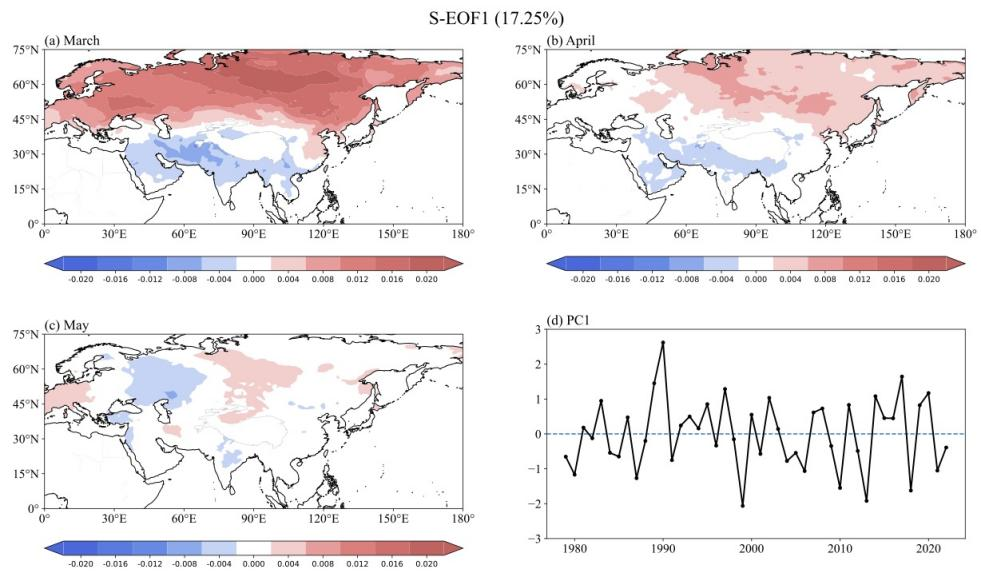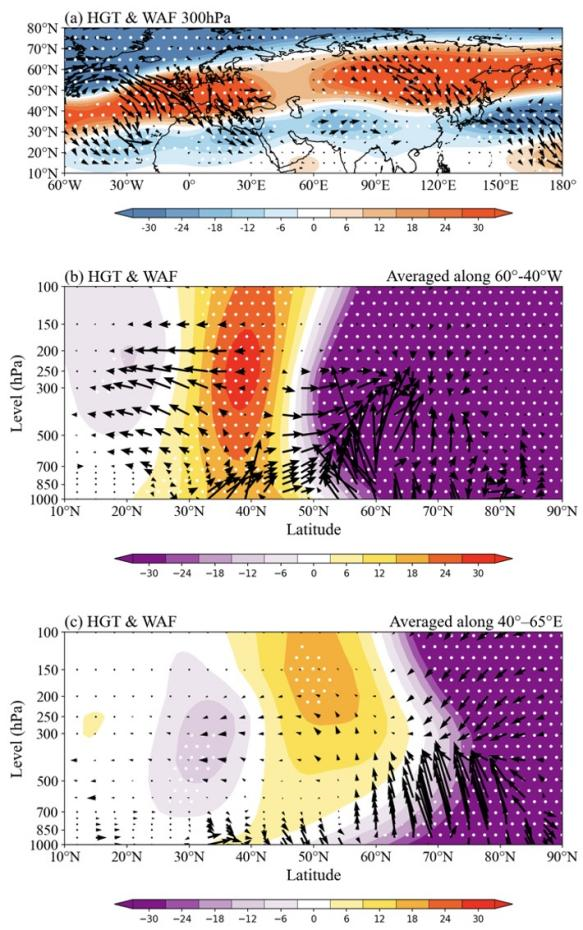近年来,随着全球变暖进一步加剧,欧亚大陆前春冷空气活动频繁、极端温度事件频发且灾害性强,给自然环境、人类生活和社会经济等方面均造成了极大威胁。近日,、李惠心副教授(通讯作者)和其硕士研究生袁嫄(第一作者)等探讨了3月欧亚大陆地表温度的分布特征及其可能的影响机制,相关成果发表于期刊《Atmospheric Research》。
本研究首先揭示了3月欧亚大陆地表温度的分布特征,根据S-EOF分析结果表明,在1979–2022年间欧亚大陆3月地表温度第一模态呈现“南正北负”的偶极子型分布,并发现北半球存在两条来自中高纬及极地地区的波列。进一步分析表明,该偶极子型温度分布与北大西洋三极子型海温异常及巴伦支海海冰负异常密切相关。北大西洋三极子型海温异常可通过地表净辐射通量调节大气环流,在北大西洋中纬度地区激发一条向东传播至欧亚大陆的波列,使得欧亚大陆北部暖平流加强,南部云量增多,到达地表的太阳辐射减少,进而影响欧亚大陆西北、东北及西南地区地表温度异常分布。关于巴伦支海海冰对欧亚大陆地表温度的影响机制与海温类似,由回归分析结果表明,巴伦支海海冰负异常可通过激发向南传播的波列调节大气环流从而影响欧亚大陆中部、西南及东南地区的地表温度异常分布。为了进一步验证北大西洋海温及巴伦支海海冰异常对欧亚大陆地表温度的影响,本研究利用CAM5模式设计了四组不同边界条件的敏感性试验。由北大西洋三极子型海温异常及巴伦支海海冰负异常共同强迫的敏感性试验结果表明,除了在欧亚大陆东北部分区域外,能够很好地再现观测结果中所得到的欧亚大陆地表温度南北偶极子型分布特征以及分别来自北大西洋及巴伦支海的相关波列。因此,观测及模式结果均表明,北大西洋三极子型海温异常及巴伦支海海冰负异常均可通过激发波列调节大气环流从而影响欧亚大陆地表温度的偶极子型分布特征。

Fig. 1. (a–c) The spatial distribution of the first S-EOF mode of Eurasian surface air temperature (from March to May) and (d) the corresponding normalized PC time series (PC1) of springtime during 1979–2022

Fig. 2. Regression maps of March geopotential height (shading; gpm) of (a) 300 hPa horizontal, (b) vertical-horizontal cross-section averaged along 40°–60°W, and (c) vertical-horizontal cross-section averaged along 40°–65°E with regard to the normalized S-EOF PC1 during 1979–2022 and the associated wave activity flux (vectors; m2·s-2). The dotted indicate the regression coefficients significant at the 90% confidence level based on the Student’s t-test
文章信息:
Yuan, Y., Li, H. X., Sun, B., Wang, H. J., He, S. P., Li, F., Li, H., 2024: Joint influence of the North Atlantic sea surface temperature and the Barents sea-ice concentration on the dipole pattern of Eurasian surface air temperature in March. Atmospheric Research, 305, 107446. https://doi.org/10.1016/j.atmosres.2024.107446.
